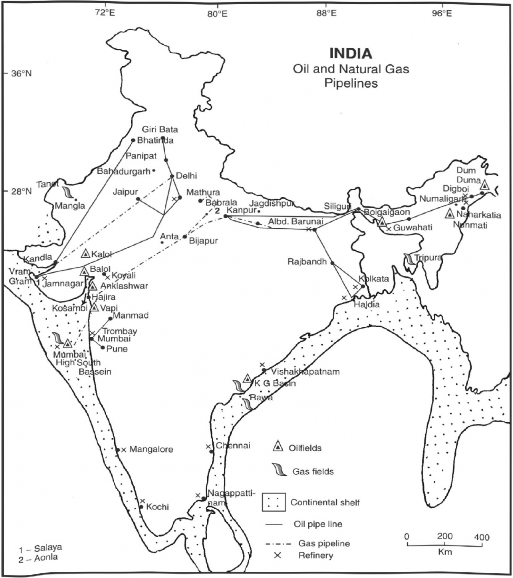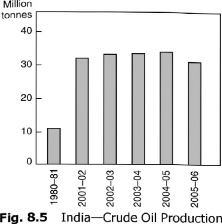Petroleum
Petroleum is an important source of energy which is much in demand to accelerate the economic development. Apart from an important fuel resource, it provides lubricants and raw materials for a number of chemical industries. Its products include kerosene, diesel, petrol, aviation-fuel, synthetic rubber, synthetic- fibre, thermoplastic resins, benzene-methansol, polystertene, acrylates, detergents, aromatics, gasoline, carbon-black, dyes, colours, food-colours, pigments, explosives, printing ink, film-photography, greases, cosmetics, paints, lubricant oils, paraffin, and wax.
Crude oil is obtained mainly from the sedimentary rocks of marine origin. In India, crude oil is found in the sedimentary rocks of the Tertiary period (Fig. 8.4). Normally it does not occur at its place of formation. Being lighter than water, crude oil overlain with gas, gets accumulated in the anticlines above the water surface. The geologists propounded two theories about the origin of crude oil.
Origin.'The origin of petroleum and natural gas is considered to be organic. According to organic origin, the living organisms (marine life, like fish) and vegetal matter got buried under the accumulated sediments of mud, silt and sand, etc. Due to pressure and heat, this undergoes chemical changes so as to form crude oil and natural gas after millions of years.
Oil in India was discovered near Margherita (Upper Assam); for the first time in 1860 by the Assam Railway and Trading Company. Subsequently, oil was discovered at Digboi in 1889. In the beginning of the 20th century (1917), oil was discovered at Badarpur (Assam). In 1954, production of oil was started in
Naharkatiya region. The Oil and Natural Gas Commission (ONGC) was established in 1956. With the efforts of the Oil and Natural Gas Commission (ONGC), oil was discovered in the Gulf of Cambay (Khambat) in 1961 and in Bombay High in 1976.

Fig. 8.4 Oil and Natural Gas Deposits
In India, the petroleum and natural gas has been discovered in the following ten basins: (60,000 sq km)
(60,000 sq km) (1(H),000 sq km)
(95,000 sq km)
(140,000 sq km)
(385,000 sq km)
(75,000 sq km)
(2000 sq km)
(2000 sq km)
1. The Upper Assam Basin
2. The Western Bengal Basin
3. The Western Himalayan Basin
4. The Rajasthan Saurashtra-Kachchh Basin
5. The Northern Gujarat Basin
6. The Ganga Valley Basin
7. The Coastal Tamil Nadu, Andhra & Kerala Basin
8. The Andaman and Nicobar Coastal Basin
9. Offshore of the Khambat, Bombay High & Bassein The production trend of oil has been given in Table 8.3 Table 8.3 India—Production of Crude Oil—1951-2006
Year | Production in Million Tonnes |
1950-51 | 0.27 |
1960-61 | 0.50 |
1970-71 | 7.20 |
1980-81 | 15.5 |
1990-91 | 33.0 |
2000-01 | 32.5 |
2005-06 | 34.0 | |
Source: Economic Survey of India, 2009-10.
It may be seen from Table 8.3 that the total production of crude oil in 1950—51 was only 0.27 million tonnes which rose to 34 million tonnes in 2005-06. The produced oil is, however, only about 40 per cent of the domestic need. The production of crude oil from the different regions of the country has been shown in Table 8.4.
Table 8.4 India: Production of Crude-Oil—2005-06
State/Region | Production in Thousand Tonnes | Per cent of all India Production |
1. Bombay High | 22.10 | 65.00 |
2. Gujarat | 06.00 | 17.65 |
3. Assam | 05.10 | 15.00 |
4. Andhra Pradesh | 00.39 | 1.15 |
5. Tamil Nadu | 00.37 | 1.10 |
6. Arunachal Pradesh | 00.04 | 0.10 |
All India | 34.00 | 100.00 |
Source: Statistical Abstracts of India, 2007.
The crude oil production in India has been shown in Fig. 8.5. It may be seen from Fig. 8.5 that the crude oil production was about eleven million tonnes in 1980-81 which rose to over 34.0 million tonnes in 2005-06.
It may be observed from Fig- 8.5 that over 65 per cent of the total oil production is from the Bombay High. The second and third ranks are that of Gujarat (about
18 per cent) and Assam (15 per cent).

